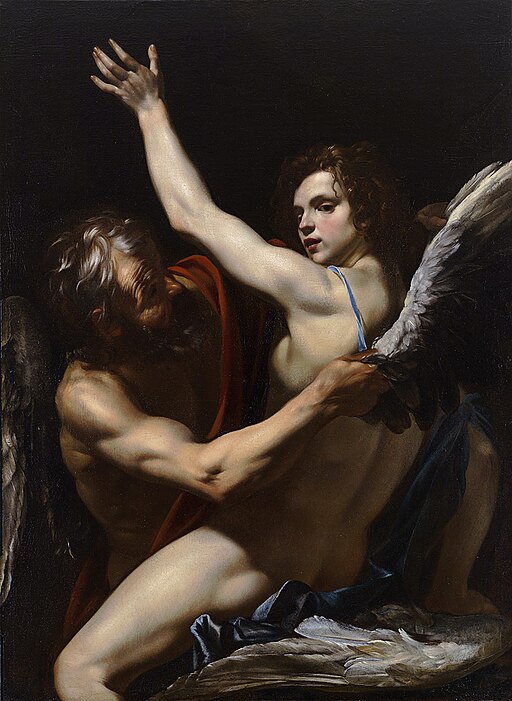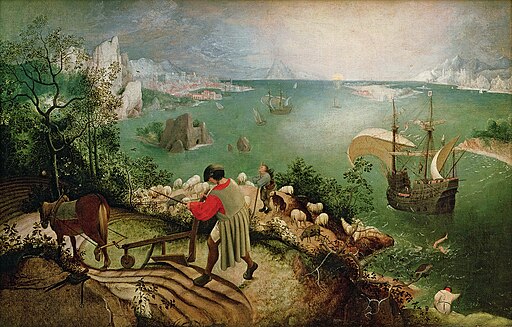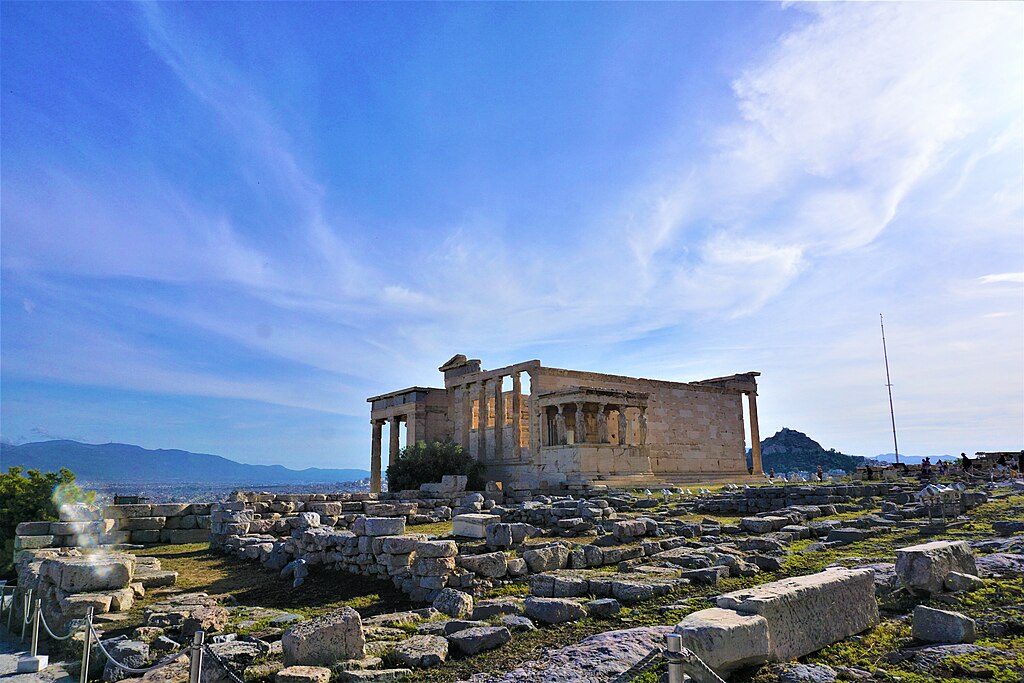
Many famous painters have captured the story of “The Fall of Icarus” in Art:
- “The Fall of Icarus” by Jacob Peter Gowy – Museo del Prado, Madrid
- “Daedalus and Icarus” by Anthony van Dyck – Art Gallery of Ontario
- “The Lament for Icarus” by Herbert James Draper – Tate Britain
- “Daedalus and Icarus” by Charles Le Brun – Hermitage Museum
- “The Fall of Icarus” by Merry-Joseph Blondel – Louvre Museum
- “Icarus and Daedalus” by Frederic Leighton – Private Collection
- “Daedalus and Icarus” by Orazio Riminaldi – Wadsworth Atheneum, Hartford
- “Landscape with the Fall of Icarus” by Pieter Brueghel the Elder – Royal Museums of Fine Arts of Belgium
- “Daedalus and Icarus” by A.G.L. Desnoyers after C.P. Landon – Wellcome Collection
“The Fall of Icarus” by Jacob Peter Gowy
“The Fall of Icarus” by Jacob Peter Gowy depicts the moment when the wax in Icarus’s wings melted, and he tumbled out of the sky and fell into the sea where he drowned.
Icarus’s wings were held together with wax, which melted when he flew too close to the sun, and this story sparked the idiom “don’t fly too close to the sun.”
In Greek mythology, Icarus and his father were attempting to escape their prison, employing wings that his father constructed from feathers and wax. Icarus’ father, however, did warn him not to fly too low nor too high.
He warned him not to fly low as the sea’s dampness would clog his wings. And not too high as the sun’s heat would melt the wax in his wings.
Icarus ignored his father’s instructions and flew too high, and the wax in his wings melted. Icarus’s father, Daedalus, looks on unable to help his son as he falls past him.
His son’s calamity left Daedalus heartbroken, but instead of giving up, he flew to the island of Sicily.
Jacob Peter Gowy (1610 – before 1664) was a Flemish Baroque painter of history paintings and portraits. He collaborated with Peter Paul Rubens and spent time in England, where he was active as a portrait painter.
“The Fall of Icarus” by Jacob Peter Gowy
- Title: The Fall of Icarus in Art
- Español: La caída de Ícaro
- Artist: Jacob Peter Gowy (or Gouwy)
- Created: 1637
- Media: Oil on canvas
- Dimensions: Height: 195 cm (76.7″); Width: 180 cm (70.8″)
- Type: Mythological Art
- Museum: Museo del Prado, Madrid
~~~
“Daedalus and Icarus” by Anthony van Dyck

“Daedalus and Icarus” by Anthony van Dyck
“Daedalus and Icarus” by Anthony van Dyck shows Icarus’s father warning his son Icarus first of complacency and then of hubris as he points to his head.
Icarus is trying to impress on his youthful son not to be complacent and fly too low as the sea’s dampness would not clog his wings. He also warns Icarus of the hubris of flying too high to the sun where the heat will melt the wax in his wings.
Unfortunately, the young Icarus ignored or forgot his father’s instructions not to fly too high to the sun, and when the wax in his wings melted, he tumbled out of the sky.
Icarus drowned in the area which today bears his name, the Icarian Sea near Icaria, an island southwest of Samos, Greece
Anthony van Dyck (1599 – 1641) was a Flemish Baroque artist who became the leading court painter in England after his success in the Southern Netherlands and Italy.
He is best known for his portraits of European aristocracy, most notably Charles I and his family and associates.
“Daedalus and Icarus” by Anthony van Dyck
- Title: Daedalus and Icarus
- Artist: Anthony van Dyck
- Created: 1625
- Media: Oil on canvas
- Dimensions: Height: 1,153 mm (45.39″); Width: 864 mm (34.01″)
- Type: Mythological Art
- Museum: Art Gallery of Ontario
~~~
“Daedalus and Icarus” by Charles Le Brun

“Daedalus and Icarus” by Charles Le Brun
“Daedalus and Icarus” by Charles Le Brun depicts the fabled inventor Daedalus, who made wings for himself and his son to escape from their prison tower.
The figures are skillfully shown in complex foreshortening, creating a dynamic composition through the use of contrasts in light and shade.
The cold greenish-blue of the ominous sky and the warm golden-brown draperies contrast with the pale body of Icarus.
In Greek mythology, Daedalus was a skillful architect and craftsman full of wisdom and knowledge. He invented and built the Labyrinth for King Minos of Crete.
However, after finishing the Labyrinth, the King had Daedalus imprisoned to preserve the secrets of the Labrinth. Daedalus and his son Icarus devised a plan to escape by using wings made of wax that Daedalus had invented.
Charles Le Brun (1619 – 1690) was a French painter, art theorist, and a director of several art schools of his time.
As a court painter to Louis XIV, who declared him “the greatest French artist of all time,” he was a dominant figure in 17th-century French art. Le Brun created in this painting a dramatic image using realism and powerful modeling.
“Daedalus and Icarus” by Charles Le Brun
- Title: Daedalus and Icarus
- Artist: Charles Le Brun
- Created: 1646
- Media: Oil on canvas
- Dimensions: Height: 190 cm (74.8″); Width: 124 cm (48.8″)
- Type: Mythological Art
- Museum: Hermitage Museum
~~~
“The Fall of Icarus” by Merry-Joseph Blondel

“The Fall of Icarus” by Merry-Joseph Blondel
“The Fall of Icarus” by Merry-Joseph Blondel is an oil painting on the ceiling of the Rotunda of Apollo, in the Louvre museum, in Paris. Blondel depicts Icarus falling after his wings melted when he flew too close to the Sun god Helios.
Helios in ancient Greek myth was the god and personification of the Sun, depicted with a radiant crown and driving a horse-drawn chariot through the sky.
Icarus’s father is shown in distress as he hopeless watches his son fall to his death after he ignored his father’s advice not to fly too close to Helios.
Merry-Joseph Blondel (1781 – 1853) was a French history painter of the Neoclassical school. He was a winner of the prestigious Prix de Rome in 1803.
He was bestowed with the rank of Knight in the order of the Legion d’Honneur by Charles X of France and was elected to a seat at the Académie des Beaux-Arts in Paris.
“The Fall of Icarus” by Merry-Joseph Blondel
- Title: The Fall of Icarus
- Artist: Merry-Joseph Blondel
- Created: 1819
- Medium: Oil
- Dimensions: H. 2.71 m (106 ½ in.), W. 2.1 m (82 ½ in.)
- Type: Mythological Art
- Museum: Louvre Museum
~~~
“Icarus and Daedalus” by Frederic Leighton

“Icarus and Daedalus” by Frederic Leighton
“Icarus and Daedalus” by Frederic Leighton depicts Icarus being prepared for flight by his father, Daedalus. Icarus is almost nude, save for some billowing drapery is standing on a marble ledge. Icarus is reaching up to grasp the handle to the wings fastened on his back. However, he seems to be ignoring his father’s warning.
Leighton has captured the moments before Icarus’s hubris leads to his downfall. This overconfidence is symbolized by his single-minded gaze towards the horizon and his grasping at air rather than his hand-strap.
Lord Leighton was successful during his lifetime because his paintings brilliantly captured the Victorian nostalgia and longing for the glorious “Golden Age” of ancient Greece and Rome.
In classically inspired oil paintings, Leighton depicted an idealized vision of the past that perfectly appealed to the sensibilities of the time.
“Icarus and Daedalus” by Frederic Leighton
- Title: Icarus and Daedalus
- Artist: Frederic Leighton
- Created: 1869
- Media: Oil on canvas
- Dimensions: Height: 138.2 cm (54.4″); Width: 106.5 cm (41.9″)
- Type: Mythological Art
- Museum: Private collection
~~~
“Daedalus and Icarus” by Orazio Riminaldi

“Daedalus and Icarus” by Orazio Riminaldi
“Daedalus and Icarus” by Orazio Riminaldi depicts the wrinkled face and tan, muscular right arm of the farther as he assists his young son with their only hope for freedom.
The young Icarus has curly hair, a smooth pale complexion, and the body of a boy.
His brightly lit thigh and arm are in sharp contrast to the dark background creating an atmosphere that heightens the viewer’s empathy for the inevitable destiny of this youth.
Orazio Riminaldi (1593 – 1630) was an Italian painter who painted mainly history subjects in a Caravaggist style.
“Daedalus and Icarus” by Orazio Riminaldi
- Title: Daedalus and Icarus
- Artist: Orazio Riminaldi
- Created: 1625
- Media: Oil on canvas
- Dimensions: Height: 132 cm (51.9″); Width: 96.1 cm (37.8″)
- Type: Mythological Art
- Museum: Wadsworth Atheneum, Hartford, Connecticut
~~~
“Landscape with the Fall of Icarus” by Pieter Brueghel the Elder

“Landscape with the Fall of Icarus” by Pieter Brueghel the Elder
“Landscape with the Fall of Icarus” by Pieter Brueghel the Elder is an excellent copy by an unknown artist of Bruegel’s lost original. The plowman, shepherd, and angler in the painting are mentioned in famous Ovid’s account of the legend, in which they are:
“astonished and think to see gods approaching them through the aether.”
The painting contains these figures, but they seem to be oblivious to Icarus’s fate. This composition may be intended to illustrate the Flemish proverb: “And the farmer continued to plow…”
The painting is highlighting humanity’s indifference to other people’s suffering.
Pieter Bruegel (also Brueghel) the Elder (1525 – 1569) was the most significant artist of Dutch and Flemish Renaissance painting, a painter known for his landscapes and peasant scenes.
He influenced the Dutch Golden Age painting with his innovative choices of subject matter, as one of the first generation of artists to grow up when religious subjects had ceased to be the dominant subject matter of painting.
“Landscape with the Fall of Icarus” by Pieter Brueghel the Elder
- Title: Landscape with the Fall of Icarus
- Artist: Pieter Brueghel the Elder
- Year: 1558
- Medium: Oil on canvas mounted on wood
- Type: Mythological Art
- Dimensions: 73.5 × 112 cm (28.9 × 44.1 in)
- Museum: Royal Museums of Fine Arts of Belgium
~~~
“Daedalus and Icarus” by A.G.L. Desnoyers after C.P. Landon

“Daedalus and Icarus” by A.G.L. Desnoyers after C.P. Landon
“Daedalus and Icarus” is an engraving by A.G.L. Desnoyers from C.P. Landon’s painting. The engraving shows Daedalus the father launching his son Icarus into flight. Landon’s “Daedalus and Icarus” is an oil on canvas painting from 1799.
In the Greek myth, Daedalus had created two pairs of wings out of wax and feathers for himself and his son. Daedalus tie Icarus’s wings first, but warned his son not to fly too close to the sun, nor too close to the sea, but to follow his father’s flight path.
Overcome by the giddiness of flying, Icarus soared into the sky. Icarus came too close to the sun, which due to the heat, melted the wax.
Icarus kept flapping his wings but soon realized that he had no feathers left and that he was only flapping his bare arms, and so Icarus fell.
Auguste Gaspard Louis, Baron Boucher-Desnoyers (1779 in Paris – 857) was one of the most eminent of modern French engravers.
Charles Paul Landon (1760 – 1826) was a French painter and famous writer on art and artists.
“Daedalus and Icarus” by A.G.L. Desnoyers after C.P. Landon
- Title: Daedalus and Icarus
- Artist: Engraving by A.G.L. Desnoyers after C.P. Landon.
- Created: 1800s
- Media: Oil on canvas
- Type: Mythological Art
- Museum: Wellcome Collection
The Myth of Icarus and Daedalus Explained
~~~
“Don’t fly too close to the sun.”
– Ancient Greek Proverb
~~~
Photo Credit 1) Jacob Peter Gowy / Public domain; Anthony van Dyck / Public domain; Herbert James Draper / Public domain; Charles Le Brun / Public domain; Pieter Bruegel the Elder / Public domain; Frederic Leighton, 1st Baron Leighton / Public domain; Louvre Museum / CC BY Wikimedia Commons; See page for author / CC BY Wikimedia Commons
Popular this Week








 Sponsor your Favorite Page
Sponsor your Favorite Page SEARCH Search for: Search Follow UsJoin – The JOM Membership Program
Sponsor a Masterpiece with YOUR NAME CHOICE for $5
Share this:
- Tweet
